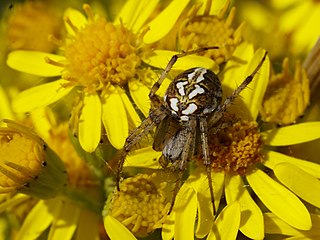
Wolf spiders are members of the family Lycosidae. They are robust and agile hunters with excellent eyesight. They live mostly in solitude, hunt alone, and usually do not spin webs. Some are opportunistic hunters, pouncing upon prey as they find it or chasing it over short distances; others wait for passing prey in or near the mouth of a burrow.

Orb-weaver spiders are members of the spider family Araneidae. They are the most common group of builders of spiral wheel-shaped webs often found in gardens, fields, and forests. The English word "orb" can mean "circular", hence the English name of the group. Araneids have eight similar eyes, hairy or spiny legs, and no stridulating organs.

Neoscona, known as spotted orb-weavers and barn spiders, is a genus of orb-weaver spiders (Araneidae) first described by Eugène Simon in 1895 to separate these from other araneids in the now obsolete genus Epeira. The name Neoscona was derived from the Greek νέω, meaning "spin", and σχοῖνος, meaning "reed" They have a mostly pantropical distribution and one species, Neoscona adianta, has a palearctic distribution. As of April 2019 there are eight species that can be found in the United States and Canada:
Kurt Grasshoff was a German pilot who commanded Jasta 37 in France and Jasta 38 in Macedonia in World War I. He commanded German ace Ernst Udet in Jasta 37, and chose Udet to command the unit upon his transfer to Jasta 38.
Alexander Grasshoff was an American documentary filmmaker and director who received three Oscar nominations.

Fritz Graßhoff was a German painter, poet and songwriter. He was known for hits sung by Lale Andersen, Freddy Quinn and Hans Albers. As a painter, he participated in important exhibitions; as a writer, he was known for his lyric volume Halunkenpostille and his autobiographical novel Der blaue Heinrich. He translated poetry by the Ancient Roman Martial and the Swede Carl Michael Bellman. Many of his writings have been set to music by composers such as James Last, Norbert Schultze and Siegfried Strohbach.
Halunkenpostille is the title of a collection of poetry by the German writer Fritz Graßhoff. It could be translated as Scoundrel's Postil, and it reflects the title of Bertolt Brecht's Hauspostille, a collection of poems, which parodies Martin Luther's Hauspostille, a collection of Bible commentaries. A recording of songs from the Halunkenpostille was subtitled Schräge Songs, halbseidene Lieder und wunderschöne Gedichte, which may be rendered as Cockeyed Songs, Dubious Ditties and Wonderful Poems. The style shows similarities to works by Erich Kästner, Walter Mehring and Joachim Ringelnatz.

Larinia is a genus of orb-weaver spiders first described by Eugène Simon in 1874.

Caerostris, sometimes called bark spiders, is a genus of orb-weaver spiders first described by Tamerlan Thorell in 1868. Most species are found in south eastern Africa and neighboring Madagascar.

Eriovixia is a genus of orb-weaver spiders first described by Allan Frost Archer in 1951.
Kilima is a genus of African orb-weaver spiders first described by M. Grasshoff in 1970. As of April 2019 it contains only three species.

Lariniaria is a genus of Asian orb-weaver spiders containing the single species, Lariniaria argiopiformis. It was first described by M. Grasshoff in 1970, and has only been found in Russia, China, Korea, and Japan.
Mahembea is a genus of African orb-weaver spiders containing the single species, Mahembea hewitti. It was first created by M. Grasshoff in 1970 to separate this species from its original genus, Larinia. It has only been found in Central and East Africa.

Megaraneus is a genus of African orb-weaver spiders containing the single species, Megaraneus gabonensis. It was first described by R. F. Lawrence in 1968, to contain the single species originally published under the name Epeira gabonensis.
Paralarinia is a genus of African orb-weaver spiders first described by M. Grasshoff in 1970.
Prasonica is a genus of orb-weaver spiders first described by Eugène Simon in 1895.
Prasonicella is a genus of East African orb-weaver spiders first described by M. Grasshoff in 1971. As of April 2019 it contains only two species.
Umbonata is a genus of Tanzanian orb-weaver spiders containing the single species, Umbonata spinosissima. It was first described by M. Grasshoff in 1971 to contain the single species moved from Mangora.
Siwa is a genus of orb-weaver spiders first described by M. Grasshoff in 1970. As of April 2019 it contains only two species.








